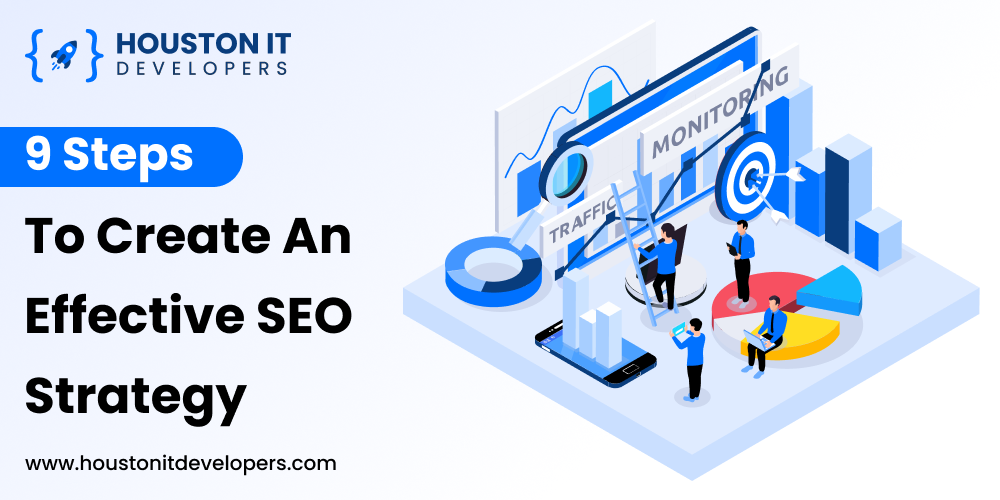What use is a website if no one’s visiting it? If you want it to meet your business goals, you have to continuously strive to get people to visit your website to start with. Here is where Search Engine Optimization (SEO) will help you meet your goals.
SEO refers to the process and strategy implemented to ensure better ranking in the search engine result pages (SERPs). As most people use Google to search for anything by default, aligning your website to comply with Google’s search algorithms is extremely important. But there are hundreds if not thousands of websites similar to yours in your niche, how do you outrank them in the SERPs? The answer- an effective SEO strategy that helps you gradually increase your search rankings organically. Let’s see how to do this-
How to create an effective SEO strategy in 2022
Step #1: Make a list of keywords
Keyword research is the first step in the any SEO strategy. The best way to find keywords is through Google Suggest- just type a search term related to your niche and you’ll get a list of all the related keywords popular in your niche. Alternatively, you could use the ‘Discover new keywords’ tool in a Google Ads account.
The related keywords list would contain single-word phrases, 2-3 word phrases, and long-tail keywords. For instance, a single word phrase could be ‘t-shirts’ which is quite a generic keyword. A more specific keyword would be ‘yellow t-shirts’. As you are just starting, it is very difficult to get a better ranking on generic keywords. Instead, you could first target low-volume and low competition long-tail keywords like ‘Blue casual t-shirt’.
Step #2: Analyze your target keyword’s search pages
Once you’re done with the keyword research, examine each keyword’s search page. Which websites rank on the first page? What kind of content do they have that ranks? How have they presented the content? What type of content is missing in the SERPs? Ask yourself these questions and hunt for answers. These answers would determine the next course of action.
Step #3: Create website content that’s different or better
Once you have understood what’s missing in the SERPs, create content that fills the gaps. For instance, if one of your keywords is ‘How to use a Swiss knife?’ and most of the results are ‘X ways to use a Swiss army knife’ or ‘Tips & Tricks to use a Swiss army knife’, you could create an article on ‘ Unknown ways you could use your Swiss Knife’ or ‘How NOT to use your Swiss knife’.
Step #4: Get Backlinks
When creating content, ask yourself- what interests the customer in the content? What more would they like to know besides what is presented to them? Let’s take the above example. When you are writing about ‘Unknown ways you could use your Swiss knife’, you could include content that would further interest them. History, tidbits, or facts and figures are what we’re talking about. You could also write another article on this topic and link it to the article. For instance, you could write on ‘History of the Swiss army knife’ and link it to your ‘Unknown ways you could use your Swiss knife’ content.
When people understand and appreciate the content, they will share the content on social media or their own blogs, increasing traffic to your website.
Step #5: Optimize for on-page SEO
Though this is a one-time effort, you have to take care when you optimize for on-page SEO. Firstly, examine each page- link those pages with high traffic to new pages or pages with lesser traffic. Secondly, ensure your URLs are short and sweet, as short URLs always outperform longer ones.
Besides this, use what is called Semantic SEO service, where you can add long-tail keywords that are related to the target keyword. You may remember the ‘Searches related to’ options you get just before the end of the SERP which has the number of results. You also need to make sure your website is easy to use, intuitive, fast, and has an interface that looks interesting.
Step #6: Optimize for Search Intent
We usually write content to increase search traffic. Though this is valid, you should also consider search intent. For instance, you could write a post on ‘How to use a kitchen knife, but a better search intent and interesting title would be ‘X ways you didn’t know you could use your kitchen knife’. This is what interests people, rather than generic titles containing how, what, or where. You could also start with numbers to garner more interest.
Step #7: Focus on unique content development
There is so much content out there. You could visit any website and get content that matches your search intent. But hold on to that thought. As mentioned in Step #6, you need to create unique content. When someone skims through the SERP, they are most likely to ignore titles like ‘How to use a software, ‘ instead, they’ll click on ’10 things you didn’t know you could do with X software’. This is even if this title is ranked a little lower down the list.
Step #8: Build Backlinks
Similar to Step #4, here, you have to take initiative and build backlinks. This is perhaps the most challenging part of SEO. Building backlinks takes time-sometimes months. The more quality backlinks you have, the better chance you have at ranking at #1 on the SERPs. Due to the difficulty of this process, many website owners hire SEO services to get this done. For any website, ranking to the first page could take a minimum of 3-6 months for any web page.
Step #9: Keep updating and creating new content
Content creation is not a do it once and forget it job. Just because your website traffic is increasing does not mean you do not create or update content. You never know when your competitor could surpass you in the SERPs, while your traffic decreases day by day. In other words, you need to update and create content to maintain and increase the traffic to your website.
In the end
With cut-throat competition in every niche, getting found online requires consistent efforts. For businesses like yours, to get relevant leads, you have to invest well in SEO and digital marketing. It is the ideal strategy to meet your business goals and take your business to heights you never imagined.








